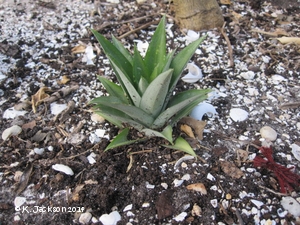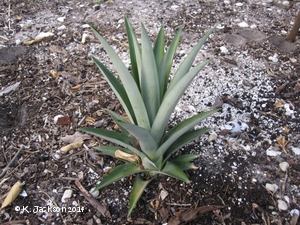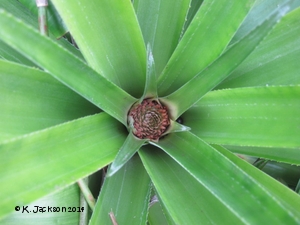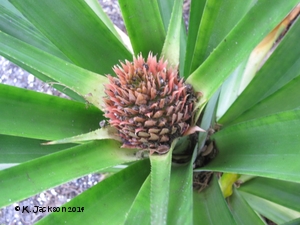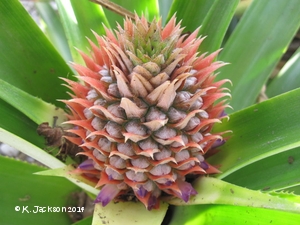How to grow a pineapple Pineapple is one of the world's most unique and exotic tropical fruits, yet it is possible to grow it in a temperate zone under controlled conditions. Although you may not be able to grow as large a plant as is grown on a plantation in Hawaii, the following information should permit you to grow a healthy, attractive pineapple for your home. Crowns (or "tops", leafy tops of the fruit), slips (grow from the fruit itself or along the stalk below the fruit), suckers from axils of leaves (these produce fruit more quickly) and ratoons (the growth from underground stems) have all been commonly utilized for vegetative multiplication of the pineapple. To a lesser degree, some growers have used "stumps", that is, mother plant suckers that have already fruited. 2 All four types work, although slips and suckers are preferred in commerce. Fortunately, each pineapple fruit in the supermarket comes with a crown which can be used to start the plant which will develop slips and suckers for subsequent use. 3 Preparing a crown Fig. 1 Root primordia (brown spots) as seen on the butt of a freshly cut pineapple crown intended for vegetative reproduction. Remove the crown from your pineapple by twisting or cutting it off. Any adhering flesh should be trimmed off its base, or it might rot after planting. After trimming, cut the bottom of the crown (its stem) until you see root buds, which are small round structures visible around the perimeter of the stem base. Remove as little tissue as possible to avoid cutting into young stem tissue. To make planting easier, you can also strip off some of the lower leaves, exposing up to about three-fourths of an inch of the base of the crown. The small brown-colored bumps below the leaf scars are root primordia (the beginnings of roots) and there may even be a few short roots at the base of the crown. After trimming and stripping, place the crown upside down in a dry, shaded place for about a week (5 to 7 days) before planting. This will permit the cut end and the leaf scars to heal and prevent rot. Planting Pineapple plants are an excellent choice for planting in home landscapes with little open space. In general, pineapple plants should be planted in full sun for best growth and fruit production. Select a part of the landscape at least 5 feet (1.5 m) away from other trees, buildings and structures where minimal shading occurs. The distance between individual pineapple plants ranges from 12 to 36 inches (21-91 cm). In general, wider spacing among plants allows for production of larger plants and fruit than close spacing among plants. 1 Removing suckers, slips, and hapas during plant growth and fruit development will hasten the development of the fruit and increase fruit size. However, allowing a few suckers or slips or hapas to grow will supply new planting material. After the first fruit is harvested. 1
Pineapple plants are well adapted to planting in a container. Choose a 3- to 7-gallon (11- to 26-liter) container with drainage holes. The larger the container, the greater the potential for a large plant and fruit; small containers restrict the size of the plant and resulting fruit size. Use a well-drained potting soil mix and fill the container to within an inch (2.5 cm) or so of the top. Water the soil before planting the plant (water should be seen draining from the drainage holes). Plant the pineapple in the center of the container and water in the plant well. Place the container in full sun for best growth. When the plant flowers and fruits, tie the stalk to a stake to prevent it from falling over. Feeding Once the propagule begins to put out new leaves, a complete, soluble fertilizer should be applied monthly, according to directions which come with the fertilizer. General houseplant fertilizer is sufficient. Because the propagule will require several months to develop its root system, the water and the soluble fertilizer should be poured or sprayed over the plant so that some of it will collect in the leaf axils. After about six months, however, the fertilizer solution should be poured into the soil and not over the plant as the latter can result in damage to the developing bud. 3 Watering The pineapple plant is miserly with water, requiring only about 20 inches of natural rainfall per year, if well distributed. You need only wet the soil once a week, and when plants are indoors, it is best to apply all the water to the soil. Flowering and fruiting
Pineapples that are cultivated from a crown cutting of the fruit, will possibly flower in 20–24 months and fruit in the following six months. 4 The fruit peduncle (stem) and inflorescence develop from the apical growing point. The emergence of the inflorescence is called the red heart stage due to the reddish peduncle bracts at the base of the inflorescence. The inflorescence consists of from 50 to over 200 individual flowers and is capped by a crown of numerous short leaves (up to 150). The individual flowers are hermaphroditic with three sepals and petals, six stamens and one pistil. The flower petals are white at their bases to violet-blue at their tips. Each flower is surrounded by a hairy bract. Generally the first flowers open 50 or so days after flower induction and flowering continues for 20 to 40 days. Usually one to 10 flowers open daily beginning around midnight and close the following evening. Pineapple plants are self-incompatible, meaning pollen from the same variety will not result in seed production and seedy fruit. However, growing several varieties next to each other and flowering simultaneously may result in seedy fruit. To prevent seed formation, either grow only one variety or induce flowering at different times. 1 Once it flowers, the individual fruits of the flowers join together to create what is commonly referred to as a pineapple. 4 If your pineapple plant is at least 24 inches tall and has not flowered by the time it is 20 to 24 months old, you can "force" it with an inexpensive chemical. Forcing the Flowering When your fruit is about six months old, about four months after flowering has occurred, changes begin to occur. The color of the shell changes from dark purplish to green to rich gold. The color change of the shell occurs first at the bottom of the fruit and moves upwards. During this change, the fruit becomes sweeter and the color of the flesh changes from white to yellow. The fruit will weigh from two to four pounds. When the fruit is golden half way up it can be picked and eaten. You can wait longer if you wish. Other planting material After the fruit is picked, branches on the main stem of the plant -- called shoots -- and sometimes on the stem just below the fruit -- called slips --can be removed and used for planting material. After these branches are about 12 inches long, you can cut or break them off close to the stem. Many of the varieties now being grown produce few or no slips, so do not be concerned if your plant doesn't produce slips. Prepare and grow your slips and shoots in the same manner you did your crown. In the case of slips, there may be a small knob at their base. This should be cut off. Because they are larger, slips and shoots will produce a fruit in less time than to takes for a crown. It is best to use plant size as a guide in determining the best time to force flowering. Slips and shoots grow most rapidly while attached to the mother plant, so it is best to let them grow for several months after the fruit is removed. If the pineapple mother plant is large and healthy, and if you leave one or two suckers on it while the fruit is developing, additional fruit will form and be ready for harvest about a year after the initial fruit. With good care, most will continue to produce additional fruit every year for several years. If the ratoon fruit is significantly smaller than the original fruit, it is probably best to start over with new suckers taken from the mother plant. 3 Back to Pineapple Page |
||||||||||
| Bibliography 1 Crane, Jonathan. "Pineapple Growing in the Florida Home Landscape." edis.ifas.ufl.edu. One of a series of the Horticultural Sciences Department, Florida Cooperative Extension Service, Institute of Food and Agricultural Sciences, University of Florida.Original publication 1975. Re-written Oct. 2006. Revised November 2016. Reviewed Dec. 2019. Accessed 3 Mar. 2017, 13 Apr. 2020. 2 Fruits of Warm Climates. Julia F. Morton, Miami, 1987. 3 Sauls, Julian W. "Home Fruit Production - Pineapple." aggie-horticulture.tamu.edu. 1998. Web. 11 Oct. 2014. 4 "Pineapple." N.d. wikipedia.org. Web. 13 Oct. 2014. Photographs Fig. 1 Rickproser. Root primordia (brown spots) as seen on the butt of a freshly cut pineapple crown intended for vegetative reproduction. 2010. wikipedia.org. Web. 13 Oct. 2014 Fig. 2,3,4,5,6 Jackson, Karen. "Pineapple series." 2014. growables.org. JPG file Published 13 Oct. 2014 LR. Last update 13 Apr. 2020 LR |
||||||||||
